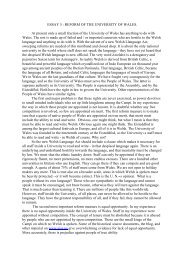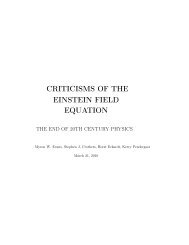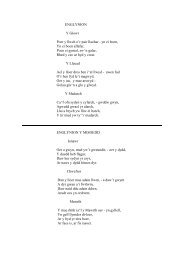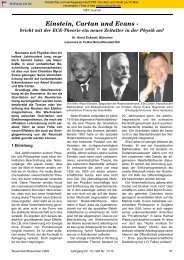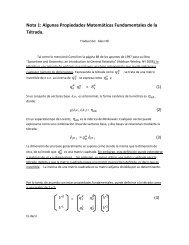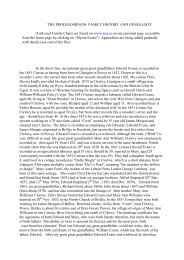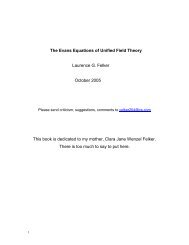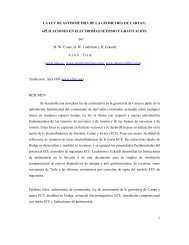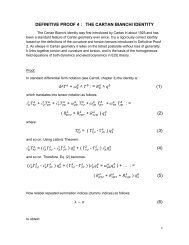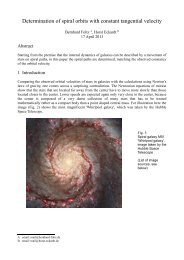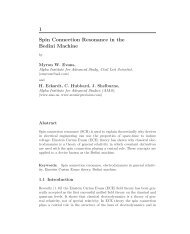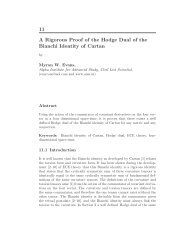Einstein, Cartan and Evans – Start of a New Age in Physics?
Einstein, Cartan and Evans – Start of a New Age in Physics?
Einstein, Cartan and Evans – Start of a New Age in Physics?
Create successful ePaper yourself
Turn your PDF publications into a flip-book with our unique Google optimized e-Paper software.
ECE Theory, H. Eckardt, L. Felker 09. Dec. 2005<br />
Albert <strong>E<strong>in</strong>ste<strong>in</strong></strong> Elie <strong>Cartan</strong> Myron W. <strong>Evans</strong> 1<br />
Horst Eckardt,<br />
Munich, Germany<br />
Laurence G. Felker,<br />
Reno, Nevada, USA<br />
<strong>E<strong>in</strong>ste<strong>in</strong></strong>, <strong>Cartan</strong> <strong>and</strong> <strong>Evans</strong> <strong>–</strong><br />
<strong>Start</strong> <strong>of</strong> a <strong>New</strong> <strong>Age</strong> <strong>in</strong> <strong>Physics</strong>?<br />
[orig<strong>in</strong>al German article to be published onl<strong>in</strong>e at: http://www.borderl<strong>and</strong>s.de/<strong>in</strong>et.jrnl.php3]<br />
Summary<br />
Although physicists have struggled <strong>in</strong> va<strong>in</strong> for over a half-century to encompass all natural<br />
forces with<strong>in</strong> a unified theory, chemical physicist Myron W. <strong>Evans</strong> has now succeeded.<br />
Based on the fundamental <strong>in</strong>sights <strong>of</strong> Albert <strong>E<strong>in</strong>ste<strong>in</strong></strong> <strong>and</strong> Elie <strong>Cartan</strong>, <strong>Evans</strong>’ theory takes<br />
the geometry <strong>of</strong> space-time itself as the orig<strong>in</strong> <strong>of</strong> all forces <strong>of</strong> Nature. As <strong>E<strong>in</strong>ste<strong>in</strong></strong> attributed<br />
gravitation to the curvature <strong>of</strong> space-time, the new theory attributes electromagnetism to the<br />
torsion or twist<strong>in</strong>g <strong>of</strong> space-time. The possibility <strong>of</strong> reciprocal <strong>in</strong>teractions between gravitation<br />
<strong>and</strong> electromagnetism -- which possibility is denied <strong>in</strong> current ma<strong>in</strong>stream physics -- leads to<br />
predictions <strong>of</strong> new physical effects which could be used to produce power <strong>and</strong> energy from<br />
space-time.<br />
1 Photograph by Al<strong>in</strong>a Hacikjana
ECE Theory, H. Eckardt, L. Felker 09. Dec. 2005<br />
Introduction<br />
For centuries, physicists <strong>and</strong> philosophers sought a unified description <strong>of</strong> all phenomena <strong>of</strong><br />
Nature. We know today that the world at the sub-microscopic quantum scale behaves very<br />
differently than our familiar macroscopic experience. In particular, theories <strong>of</strong> gravitation<br />
have been irreconcilable with quantum theory. Therefore, one expects that, if gravitation<br />
could be unified with quantum theory, wholly new <strong>in</strong>sights would result. It now appears that<br />
this unification has been achieved, but not <strong>in</strong> the manner expected by previous generations<br />
<strong>of</strong> scientists. This unification predicts fundamental new effects <strong>–</strong> for example, the production<br />
<strong>of</strong> energy (or power) without need for <strong>in</strong>put <strong>of</strong> other primary energy. This prediction, among<br />
others, is creat<strong>in</strong>g great <strong>in</strong>terest <strong>in</strong> pr<strong>of</strong>essional <strong>and</strong> scientific circles. We now review the<br />
orig<strong>in</strong>s <strong>of</strong> this unification.<br />
Albert <strong>E<strong>in</strong>ste<strong>in</strong></strong> <strong>in</strong> 1915 published a theory <strong>of</strong> the gravitational <strong>in</strong>teraction; he called this the<br />
theory <strong>of</strong> General Relativity, <strong>and</strong> today it provides the basis for our underst<strong>and</strong><strong>in</strong>g <strong>and</strong><br />
exploration <strong>of</strong> the cosmos at large. In 1905, <strong>E<strong>in</strong>ste<strong>in</strong></strong> had already produced the theory <strong>of</strong><br />
Special Relativity, which rests upon the well-known postulate <strong>of</strong> “constancy <strong>of</strong> the speed <strong>of</strong><br />
light“ <strong>in</strong> vacuum. Dur<strong>in</strong>g the last thirty years <strong>of</strong> his life, <strong>E<strong>in</strong>ste<strong>in</strong></strong> looked for a still more<br />
comprehensive unified theory which could cover all known natural forces. He spent the years<br />
from approximately 1925 to 1955 <strong>in</strong> this search, but did not reach his desired goal. S<strong>in</strong>ce the<br />
discovery <strong>of</strong> quantum mechanics <strong>in</strong> the 1920’s, the majority <strong>of</strong> physicists busied themselves<br />
with this, <strong>and</strong> not with General Relativity. The fact that quantum mechanics is consistent<br />
only with Special Relativity, but not with General Relativity, was overlooked or ignored. In<br />
addition, while quantum mechanics is successful <strong>in</strong> describ<strong>in</strong>g the electron sheath <strong>of</strong> atoms;<br />
it is not a suitable theory for the high mass-densities which occur with<strong>in</strong> atomic nuclei.<br />
Other notable progress toward unified theory <strong>in</strong> the 20th century consisted <strong>of</strong> a unification <strong>of</strong><br />
electromagnetism with the weak nuclear force, via an extension <strong>of</strong> the formalism <strong>of</strong> quantummechanics.<br />
Gravitation has rema<strong>in</strong>ed, until today, outside the St<strong>and</strong>ard Model <strong>of</strong> particle<br />
physics.<br />
Elie <strong>Cartan</strong> is less well-known than <strong>E<strong>in</strong>ste<strong>in</strong></strong>. He was a French mathematician who<br />
exchanged ideas with <strong>E<strong>in</strong>ste<strong>in</strong></strong> concern<strong>in</strong>g many details <strong>of</strong> General Relativity. <strong>Cartan</strong>’s<br />
orig<strong>in</strong>al <strong>in</strong>sight was that electromagnetism could be derived, via differential geometry, from<br />
the geometry <strong>of</strong> space-time <strong>–</strong> more or less <strong>in</strong> parallel with <strong>E<strong>in</strong>ste<strong>in</strong></strong>’s <strong>in</strong>sight that gravitation<br />
could be derived from space-time geometry.<br />
A successful unification, however, was not achieved by <strong>Cartan</strong> <strong>and</strong>/or <strong>E<strong>in</strong>ste<strong>in</strong></strong>. The<br />
unification was f<strong>in</strong>ally achieved <strong>in</strong> the year 2003 by Myron <strong>Evans</strong> who, tra<strong>in</strong>ed as a chemical<br />
physicist, brought fresh <strong>in</strong>sight to the problem. <strong>Evans</strong> held several academic pr<strong>of</strong>essorships<br />
<strong>in</strong> Engl<strong>and</strong> <strong>and</strong> the USA, before he was forced to withdraw because <strong>of</strong> his unorthodox views,<br />
<strong>and</strong> he now works as a “private researcher“ <strong>in</strong> his homel<strong>and</strong> <strong>of</strong> Wales. From there, he<br />
conducts the “Alpha Institute for Advanced Study“ (AIAS), which presents his ideas to the<br />
public as a world-wide team or work<strong>in</strong>g-group. A popular-scientific presentation is <strong>in</strong> [3].<br />
Recently concentrat<strong>in</strong>g its work on energy production from the vacuum -- a topic which<br />
established science avoids <strong>–</strong> the AIAS website generates large <strong>in</strong>terest, as shown by the<br />
steady <strong>in</strong>crease <strong>in</strong> web-page statistics on the AIAS site [4]. Many well-known universities <strong>and</strong><br />
research establishments world-wide have visited these pages.<br />
1 The four natural forces<br />
To underst<strong>and</strong> the importance <strong>of</strong> unification, one must start with knowledge <strong>of</strong> the quantities<br />
be<strong>in</strong>g unified. It is widely accepted <strong>in</strong> physics that all <strong>in</strong>teractions <strong>in</strong> Nature are<br />
manifestations <strong>of</strong> four fundamental forces. . We characterize these briefly as follows:<br />
1. The seem<strong>in</strong>gly separate force-fields generated by electrostatic charge <strong>and</strong><br />
magnetism were united <strong>in</strong> the 19th century, largely by Maxwell, <strong>in</strong>to what is now<br />
called electromagnetism, or the electromagnetic field.
ECE Theory, H. Eckardt, L. Felker 09. Dec. 2005<br />
2. The weak nuclear force is responsible for radioactive decay. Accord<strong>in</strong>g to the<br />
St<strong>and</strong>ard Model <strong>of</strong> elementary particle physics, the weak <strong>in</strong>teraction is mediated by<br />
the W- <strong>and</strong> Z-bosons, which are “virtual particles“. Neutr<strong>in</strong>os also are known to be<br />
<strong>in</strong>volved <strong>in</strong> the weak <strong>in</strong>teraction. It has been shown that the weak force is essentially<br />
the same as electromagnetism at very high energies. Thus, these two forces are said<br />
to be “already united“.<br />
3. The strong nuclear force holds protons <strong>and</strong> neutrons together. It is carried by gluons<br />
<strong>and</strong> quarks <strong>in</strong> comb<strong>in</strong>ation, although direct experimental pro<strong>of</strong> <strong>of</strong> their existence was<br />
not achieved until recently.<br />
4. Gravitation is the fourth fundamental force, but it does not fit with the theoretical<br />
picture <strong>of</strong> the other three, s<strong>in</strong>ce it is regarded (after <strong>E<strong>in</strong>ste<strong>in</strong></strong>'s General Relativity<br />
theory) as the curvature <strong>of</strong> space-time, which does not correspond to a classical force<br />
term. On the other h<strong>and</strong>, General Relativity today has been well-tested<br />
experimentally, so that nobody doubts its validity.<br />
2 Unification<br />
If a unified description <strong>and</strong> formalism could be given for these four very different forces,<br />
many new theoretical <strong>in</strong>sights <strong>and</strong> practical applications would result. In addition, mutuallyreciprocal<br />
<strong>in</strong>teractions -- which today’s ma<strong>in</strong>stream physics does not recognize -- could then<br />
be predicted <strong>and</strong> used. As we will see later, such <strong>in</strong>teractions open new possibilities for<br />
power generation. In view <strong>of</strong> the urgent global energy crisis, this might be the most important<br />
application <strong>of</strong> such a unification.<br />
The first three fundamental forces concern quantum physics (the world “<strong>in</strong> the small“), while<br />
the fourth force (gravitation) applies on all scales, <strong>in</strong>clud<strong>in</strong>g cosmic orders <strong>of</strong> magnitude.<br />
Therefore, the underly<strong>in</strong>g fundamental problem is to unify General Relativity with quantum<br />
mechanics. Conventional science has explored essentially three different pathways which<br />
might achieve this result:<br />
1. Br<strong>in</strong>g<strong>in</strong>g general relativity <strong>in</strong>to quantum physics. The <strong>in</strong>surmountable difficulty here is<br />
that time <strong>in</strong> quantum physics is treated as a unique cont<strong>in</strong>uous parameter, which is<br />
<strong>in</strong>commensurate with the quantized coord<strong>in</strong>ates <strong>of</strong> distance (or spatial displacement).<br />
2. Quantization <strong>of</strong> General Relativity. But the mathematical formalism for this approach<br />
is thus far <strong>in</strong>conclusive, <strong>and</strong> unable to make reference to experimental tests.<br />
3. Invention <strong>of</strong> a totally new theory, from which the others follow. The various “str<strong>in</strong>g<br />
theories” are examples, but they require un-physical high-dimensional spaces (N>10),<br />
<strong>and</strong> have not produced testable predictions.<br />
The solution comes, surpris<strong>in</strong>gly, <strong>in</strong> an unexpected way. By extend<strong>in</strong>g the <strong>E<strong>in</strong>ste<strong>in</strong></strong> theory<br />
along the l<strong>in</strong>es first suggested by <strong>Cartan</strong>, <strong>Evans</strong> shows that all four fundamental forces are<br />
derivable from one extended theory. This represents the long-sought Unified Field Theory.<br />
<strong>Evans</strong>’ approach does not exactly follow any <strong>of</strong> the three above-mentioned pathways,<br />
although it is closest to the third one <strong>in</strong> the list.<br />
3 Basis for <strong>Evans</strong>’ theory<br />
To underst<strong>and</strong> the basis <strong>of</strong> <strong>Evans</strong>’ theory, we must review the start<strong>in</strong>g-po<strong>in</strong>t <strong>of</strong> <strong>E<strong>in</strong>ste<strong>in</strong></strong>’s<br />
relativity theory. <strong>E<strong>in</strong>ste<strong>in</strong></strong> postulated that the presence <strong>of</strong> a massive body or an energy<br />
distribution <strong>in</strong> space (which are really <strong>in</strong>terchangeable, accord<strong>in</strong>g to the famous formula<br />
E=mc 2 ) changes the geometry <strong>of</strong> space. Viewed from right-angles with<strong>in</strong> a Euclidean<br />
coord<strong>in</strong>ate system, it “creates” a curvature <strong>of</strong> space (or, more accurately, space-time). One<br />
can write this directly as a formula:<br />
R = k T<br />
In which R designates the (tensor <strong>of</strong>) curvature, T the (tensor <strong>of</strong>) energy-momentum density,<br />
<strong>and</strong> k is a proportionality constant. The left side <strong>of</strong> this formula is geometry, the right side is
ECE Theory, H. Eckardt, L. Felker 09. Dec. 2005<br />
physics. <strong>E<strong>in</strong>ste<strong>in</strong></strong> thus used the geometry <strong>of</strong> curvil<strong>in</strong>ear coord<strong>in</strong>ates, which goes back to the<br />
mathematician Riemann. This formula implies that space-time (i.e. the three space<br />
coord<strong>in</strong>ates, <strong>and</strong> time as the fourth coord<strong>in</strong>ate) is a 4-dimensional cont<strong>in</strong>uum (or manifold)<br />
whose curvature we perceive as a force (namely gravitation).<br />
Notably, <strong>E<strong>in</strong>ste<strong>in</strong></strong>’s formula did not exploit all possible characteristics <strong>of</strong> Riemann’s geometry.<br />
It turns out that R describes only the <strong>in</strong>tr<strong>in</strong>sic curvature <strong>of</strong> the manifold; <strong>in</strong> other words, it is<br />
limited to describ<strong>in</strong>g vectors whose po<strong>in</strong>t-to-po<strong>in</strong>t variation lies entirely with<strong>in</strong> the manifold<br />
(see Fig. 1A).<br />
3<br />
1<br />
A<br />
2<br />
Spacetime<br />
Curvature<br />
A) Curvature<br />
Fig. 1: Curvature <strong>and</strong> Torsion<br />
B<br />
B) Torsion<br />
Spacetime<br />
Sp<strong>in</strong>n<strong>in</strong>g<br />
In contrast to this, <strong>Cartan</strong> employed considerations <strong>of</strong> extr<strong>in</strong>sic curvature. This means that<br />
vectors are also allowed to vary with<strong>in</strong> (<strong>and</strong> normal to) the plane tangent to the manifold at<br />
any po<strong>in</strong>t (see Fig. 1B). <strong>Cartan</strong> showed that the extr<strong>in</strong>sic curvature <strong>of</strong> space-time could be<br />
taken to represent electromagnetism as described by the Maxwell equations. Unfortunately,<br />
<strong>E<strong>in</strong>ste<strong>in</strong></strong>’s use <strong>of</strong> the mathematical concept <strong>of</strong> tensors made the relation to <strong>Cartan</strong>’s concept<br />
<strong>of</strong> geometry unclear. <strong>Cartan</strong> used the so-called “tetrad” to represent the manifold’s extr<strong>in</strong>sic<br />
curvature. In the 3-dimensional case, this reduces to a Cartesian-coord<strong>in</strong>ate “triad”, which<br />
moves along with a po<strong>in</strong>t <strong>in</strong> space. More exactly said, the tetrad specifies a tangent space at<br />
each po<strong>in</strong>t <strong>of</strong> the Riemann manifold. In this way, one ma<strong>in</strong>ta<strong>in</strong>s at each po<strong>in</strong>t a Euclidean<br />
tangent space (a so-called fiducial space), which greatly simplifies the description <strong>and</strong><br />
visualization <strong>of</strong> physical processes (Fig. 2).<br />
Fig.2: Tangent plane at a curved surface
ECE Theory, H. Eckardt, L. Felker 09. Dec. 2005<br />
Despite the value <strong>of</strong> <strong>E<strong>in</strong>ste<strong>in</strong></strong>’s <strong>and</strong> <strong>Cartan</strong>’s <strong>in</strong>sights, a united theory could not yet be<br />
formulated, because experimental <strong>in</strong>dications <strong>of</strong> how to extend Maxwell’s theory <strong>in</strong> a manner<br />
consistent with General Relativity were still miss<strong>in</strong>g. The crucial connection was found by<br />
<strong>Evans</strong> around 1990 <strong>in</strong> the sp<strong>in</strong> field or B (3) field.<br />
The decisive empirical effect -- the Inverse Faraday Effect (IFE), i.e. the magnetization <strong>of</strong><br />
matter by a beam <strong>of</strong> circular-polarized electromagnetic radiation, first observed<br />
experimentally <strong>in</strong> 1964 -- could not be expla<strong>in</strong>ed by Maxwell-Heaviside electrodynamics,<br />
except by <strong>in</strong>troduc<strong>in</strong>g an ad-hoc material property tensor.<br />
However, <strong>Evans</strong> <strong>in</strong> 1992 was able to derive the IFE directly from first pr<strong>in</strong>ciples (generallycovariant<br />
unified field theory, which <strong>in</strong>cludes general relativity), <strong>and</strong> thereby <strong>in</strong>ferred the<br />
existence <strong>of</strong> a previously unknown magnetic field component -- the B(3) field.<br />
B(3) is, <strong>in</strong>formally, a general-relativistic correction to classical electrodynamics, somewhat<br />
analogous to the general-relativistic correction to <strong>New</strong>tonian gravitation needed to expla<strong>in</strong><br />
the perihelion-advance <strong>of</strong> Mercury.<br />
The <strong>in</strong>dex numbers <strong>–</strong> (1), (2) <strong>and</strong> (3) -- here refer to the so-called circular basis; <strong>and</strong> the<br />
polarization directions B (1) <strong>and</strong> B (2) refer to the directions <strong>of</strong> transverse polarization <strong>of</strong> the<br />
field. Thus a polarization <strong>in</strong>dex must be <strong>in</strong>serted <strong>in</strong>to the Maxwell equations. This polarization<br />
<strong>in</strong>dex corresponds to the tetrad vectors q a <strong>in</strong> Fig. 2. F<strong>in</strong>ally, this leads <strong>Evans</strong> to postulate<br />
that the geometrical representation <strong>of</strong> the electromagnetic vector-potential A should be a<br />
follows:<br />
A a = A (0) q a<br />
where A is the 4x4-matrix <strong>of</strong> the complete electromagnetic potential, <strong>and</strong> A (0) is a<br />
proportionality factor. The electric <strong>and</strong> magnetic fields (comb<strong>in</strong>ed <strong>in</strong>to the tensor F a <strong>of</strong> the<br />
total electromagnetic field) then emerge directly from <strong>Cartan</strong>’s expression for the torsion T a :<br />
F a = A (0) T a<br />
In this formalism, electrodynamics is completely attributed to the geometrical torsion <strong>of</strong><br />
space-time. The complete picture, unify<strong>in</strong>g electromagnetism with gravitation, requires both<br />
Riemann curvature <strong>and</strong> <strong>Cartan</strong> torsion. The <strong>in</strong>tr<strong>in</strong>sic curvature determ<strong>in</strong>es gravitation, <strong>and</strong><br />
the extr<strong>in</strong>sic curvature (i.e., torsion) determ<strong>in</strong>es the electromagnetic field. This is described <strong>in</strong><br />
detail by suitable field equations <strong>in</strong> form <strong>of</strong> Riemann-<strong>Cartan</strong> geometry. This theory is now<br />
called <strong>E<strong>in</strong>ste<strong>in</strong></strong>-<strong>Cartan</strong>-<strong>Evans</strong> (ECE) theory, after the names <strong>of</strong> its pr<strong>in</strong>cipal authors.<br />
4 Unification with strong <strong>and</strong> weak forces<br />
Still to be described is how the rema<strong>in</strong><strong>in</strong>g two fundamental forces are represented <strong>in</strong> the ECE<br />
theory.<br />
If one analyzes the equations <strong>of</strong> the theory, it is noticeable that it is formulated for the tangent<br />
space <strong>of</strong> the Riemann manifold. The number <strong>of</strong> basis vectors <strong>of</strong> this space can be selected<br />
freely, it needs not be four-dimensional. Thereby the possibility is <strong>of</strong>fered <strong>of</strong> select<strong>in</strong>g such<br />
bases which are suitable for the description <strong>of</strong> quantized action (e.g. electron sp<strong>in</strong>).<br />
Furthermore <strong>Evans</strong> derived from <strong>Cartan</strong> geometry a wave equation, which is <strong>in</strong> pr<strong>in</strong>ciple a<br />
nonl<strong>in</strong>ear eigenvalue equation. Under certa<strong>in</strong> approximation assumptions. this equation<br />
becomes l<strong>in</strong>ear <strong>and</strong> predicts discrete stable states. Those are the “quanta” <strong>of</strong> energymomentum<br />
<strong>in</strong> quantum mechanics. All quantum-mechanical theories, <strong>in</strong> particular Dirac’s<br />
electron theory, <strong>and</strong> the strong <strong>and</strong> weak <strong>in</strong>teractions, can be deduced <strong>in</strong> this way as special<br />
cases <strong>of</strong> the ECE theory.<br />
If we compare this result with the three conventional paths to unification referred to above, it<br />
is noticeable that none <strong>of</strong> these was actually used. The new theory predicts quantum effects<br />
without assum<strong>in</strong>g them (as a postulate) from the beg<strong>in</strong>n<strong>in</strong>g. The first two forces<br />
(electromagnetism <strong>and</strong> weak force) are comb<strong>in</strong>ed, the third <strong>and</strong> fourth turn out to be<br />
derivable from other considerations. In short, there are no truly “fundamental forces” because<br />
they all emerge from geometry!
ECE Theory, H. Eckardt, L. Felker 09. Dec. 2005<br />
5 Implications for quantum physics<br />
The ma<strong>in</strong> implication is that quantum theory <strong>in</strong> its current form is not a fundamental<br />
description <strong>of</strong> Nature. In particular, the Heisenberg <strong>in</strong>terpretation <strong>and</strong> the Correspondence<br />
pr<strong>in</strong>ciple are <strong>in</strong>correct. The ECE version <strong>of</strong> quantum physics rests upon a classical, fully<br />
determ<strong>in</strong>istic basis; quantum <strong>in</strong>determ<strong>in</strong>acy plays no role. Nevertheless the equations <strong>of</strong><br />
quantum mechanics (for <strong>in</strong>stance the Schroed<strong>in</strong>ger equation) are correct <strong>and</strong> describe<br />
classical statistical processes. It would be a mark aga<strong>in</strong>st ECE theory if it did not predict this<br />
result, because the equations <strong>of</strong> quantum mechanics are experimentally verified a thous<strong>and</strong>fold.<br />
<strong>Evans</strong> also argues that the Heisenberg Uncerta<strong>in</strong>ty relation arose only by a<br />
misunderst<strong>and</strong><strong>in</strong>g, <strong>and</strong> is not justifiable. All physical mass-po<strong>in</strong>ts <strong>of</strong> a field theory are actually<br />
densities -- i.e. quanta <strong>of</strong> matter-energy spread over a volume <strong>of</strong> space. Thereby the Planck<br />
quantum <strong>of</strong> action is to be divided by the volume, for <strong>in</strong>stance, <strong>of</strong> the measur<strong>in</strong>g <strong>in</strong>strument <strong>in</strong><br />
which two complementary variables (e.g. position <strong>and</strong> momentum) are measured. The result<br />
can become arbitrarily small, i.e. the uncerta<strong>in</strong>ty can be reduced to powers <strong>of</strong> ten smaller<br />
than previously believed. An elementary particle, therefore, is neither exclusively a wave, nor<br />
exclusively a particle, but possesses characteristics <strong>of</strong> both at the same time.<br />
This sounds fantastic as a theory <strong>of</strong> physics, but exactly that was measured already some<br />
years ago [5]. The experimental refutation <strong>of</strong> the uncerta<strong>in</strong>ty relation was accomplished by<br />
ma<strong>in</strong>stream physics.<br />
Electron paths<br />
Electron<br />
source<br />
Solenoid<br />
Fig.3: The Aharonov Bohm effect<br />
Double<br />
Holes Screen<br />
As a further example <strong>of</strong> an effect which was previously difficult to expla<strong>in</strong>, we consider the<br />
Aharonov Bohm effect (Fig. 3). Two electron beams are diffracted by a double gap, at the<br />
screen, a typical <strong>in</strong>terference pattern is produced. In the diffraction zone is a closed toroidal<br />
coil. The magnetic field is circularly closed <strong>and</strong> thus rema<strong>in</strong>s with<strong>in</strong> the coil. If one now<br />
switches on <strong>and</strong> <strong>of</strong>f the magnetic field, <strong>in</strong> each case two different <strong>in</strong>terference patterns result.<br />
The closed magnetic field thus has an effect on the electron beams, although these are not<br />
<strong>in</strong> direct contact with the coil. This appears to be a quantum-mechanical “action at a<br />
distance“, which has given rise to many confusions <strong>and</strong> unsound speculations.<br />
This problem is treated <strong>in</strong> ECE theory as follows. The magnetic field <strong>of</strong> the coil creates a<br />
space-time “vortex” (due to its torsion) which extends <strong>in</strong>to the space outside <strong>of</strong> the coil itself.<br />
The pull<strong>in</strong>g effect <strong>of</strong> this vortex (i.e. the effect <strong>of</strong> vector-potential A) is then able to <strong>in</strong>fluence
ECE Theory, H. Eckardt, L. Felker 09. Dec. 2005<br />
the electron beams. Thus, the apparent “action at a distance” is reduced formally to local,<br />
causal determ<strong>in</strong>istic effect.<br />
<strong>Evans</strong> po<strong>in</strong>ts out that torsion is always accompanied by curvature. S<strong>in</strong>ce curvature is<br />
manifested as gravitational mass, it follows that the sp<strong>in</strong> <strong>of</strong> all elementary particles must<br />
contribute a component to their gravitational mass. From the neutr<strong>in</strong>o one knows this<br />
already experimentally, even if the st<strong>and</strong>ard model fails here. Also photons must possess a<br />
gravitational mass, which is extremely small, however, <strong>and</strong> is situated below current<br />
detection limits.<br />
6 Implications for technology<br />
Typically, new theories lead to practical applications only after many years. In the case <strong>of</strong><br />
nuclear fusion, the hope <strong>of</strong> produc<strong>in</strong>g useful power for society’s use rema<strong>in</strong>s unfulfilled even<br />
after 50 years. In contrast, the ECE theory suggests direct applications <strong>in</strong> diverse fields -- <strong>in</strong><br />
particular, the urgent question <strong>of</strong> energy production.<br />
The possibility <strong>of</strong> a new energy source arises from the reciprocal <strong>in</strong>teraction between<br />
gravitation <strong>and</strong> electromagnetism. Accord<strong>in</strong>g to current st<strong>and</strong>ard theory (Maxwell equations)<br />
this <strong>in</strong>teraction is not possible.<br />
However, the ECE theory predicts that a gravitational field is always connected with an<br />
electrical field, <strong>and</strong> vice-versa [6]; this might be called “electrogravitics”. The effect has been<br />
known empirically for decades, <strong>of</strong> course, but until now has lacked a quantitative description.<br />
That is now possible with assistance <strong>of</strong> the ECE theory. This application should <strong>in</strong>terest the<br />
aircraft <strong>and</strong> space <strong>in</strong>dustries greatly.<br />
In the area <strong>of</strong> electrical generators, the unipolar generator awaited an adequate explanation<br />
s<strong>in</strong>ce its <strong>in</strong>vention by Faraday <strong>in</strong> 1831. This is now completely expla<strong>in</strong>able [7]. Similarly as<br />
with the Aharonov Bohm effect, the torsion <strong>of</strong> space-time must be considered. In this case it<br />
is created due to the mechanical rotation.<br />
The most <strong>in</strong>terest<strong>in</strong>g technical application <strong>in</strong>volves the extraction <strong>of</strong> energy directly from<br />
space-time. One must underst<strong>and</strong> this as a resonance effect. First the equations <strong>of</strong> ECE<br />
theory show that matter can “transduce” energy from the surround<strong>in</strong>g space-time (one<br />
sometimes speaks also <strong>of</strong> “vacuum”). To accomplish this <strong>in</strong> practice requires that one<br />
fabricate a suitable configuration <strong>of</strong> space-time, e.g. a skillful mechanical or electromagnetic<br />
arrangement. The configuration must be so arranged that a resonant excitation <strong>of</strong> the<br />
material takes place. One knows from forced mechanical oscillations that, with suitable<br />
excitation frequency, large amounts <strong>of</strong> power can be transferred to or from the oscillat<strong>in</strong>g<br />
system.<br />
Probably many “overunity” <strong>in</strong>ventions on the alternative power scene function this way. In<br />
these cases, the <strong>in</strong>ventors found the resonance mechanism by accident. Therefore, some<br />
experiments are not repeatable, because the fundamental mechanism <strong>and</strong> critical system<br />
parameters, which led to the desired result, are not actually known.<br />
The ECE theory makes it possible to calculate these parameters exactly. The AIAS group is<br />
presently study<strong>in</strong>g the excitation mechanism, via numerical solution <strong>of</strong> the ECE equations.<br />
Experimentally the focus is on resonance excitation <strong>in</strong> electrical circuits. If one can obta<strong>in</strong><br />
power <strong>in</strong> this way, mechanically mov<strong>in</strong>g parts (as <strong>in</strong> generators) are not required; <strong>and</strong> due to<br />
the smallness <strong>of</strong> the source, each electrical appliance could, <strong>in</strong> pr<strong>in</strong>ciple, be fitted with its<br />
own power supply. The basic components would be cascadeable up to power station size.<br />
A f<strong>in</strong>al application is <strong>in</strong> medical technology. Nuclear magnetic-resonance (NMR) tomography<br />
requires very high magnetic fields, which forces a correspond<strong>in</strong>gly complex design <strong>and</strong><br />
construction. Instead one could use the Inverse Faraday Effect (described above) to<br />
generate the required magnetic fields <strong>in</strong> the patient. This requires only electromagnetic<br />
radiation <strong>in</strong> the radio-frequency range. Large solenoid coils are then not required, <strong>and</strong> the<br />
NMR apparatus could be built substantially smaller <strong>and</strong> cheaper.
ECE Theory, H. Eckardt, L. Felker 09. Dec. 2005<br />
7 Implications for cosmology<br />
The ECE theory also has implications for astrophysics <strong>and</strong> cosmology. Expansion <strong>of</strong> the<br />
universe is conventionally said to be governed by Hubble’s Law, which predicts that galaxies<br />
move away from us all the faster, the further they are distant from us. This is based on the<br />
red shift <strong>of</strong> starlight from the reced<strong>in</strong>g galaxies.<br />
However, astronomers have recently found red-shift fluctuations which cannot be reconciled<br />
with Hubble’s Law, although this is not publicly discussed. The ECE theory can expla<strong>in</strong> these<br />
deviations easily. One can translate the ECE equations <strong>in</strong>to a dielectric model. The<br />
reciprocal effect between radiation <strong>and</strong> gravitation is described there<strong>in</strong> by <strong>in</strong>troduc<strong>in</strong>g a<br />
complex-valued dielectric constant. This leads to predictions <strong>of</strong> refraction <strong>of</strong> light <strong>and</strong><br />
absorption. In areas <strong>of</strong> the universe with high mass-density, the dielectric constant is larger<br />
than <strong>in</strong> areas <strong>of</strong> low mass -density. The absorption <strong>of</strong> energy with<strong>in</strong> these areas leads to an<br />
<strong>in</strong>creased red shift. Such a model goes far beyond the Hubble model.<br />
In <strong>Evans</strong>’ theory, the cosmic background radiation accounts for absorbed radiation energy,<br />
<strong>and</strong> is not seen as evidence for the Big Bang, which does not occur <strong>in</strong> this model. Instead<br />
there are exp<strong>and</strong><strong>in</strong>g <strong>and</strong> contract<strong>in</strong>g zones <strong>of</strong> the universe adjacent to each other.<br />
8 Summary<br />
The ECE theory describes a unification <strong>of</strong> the four fundamental forces, <strong>and</strong> their reciprocal<br />
<strong>in</strong>teractions, <strong>in</strong> a simple unorthodox way. All physics becomes reduced to geometry. The<br />
quantum theory is placed on a causal determ<strong>in</strong>istic basis, while statistical description <strong>of</strong><br />
processes on the atomic level is preserved.<br />
The important po<strong>in</strong>ts <strong>of</strong> the ECE theory are the follow<strong>in</strong>g:<br />
1. Space-time is completely specified by curvature <strong>and</strong> torsion. All physics can be<br />
derived, via differential geometry, from these underly<strong>in</strong>g primordial qualities <strong>of</strong> spacetime.<br />
2. Curvature is the basis <strong>of</strong> gravitation, <strong>and</strong> torsion is the basis <strong>of</strong> electromagnetism.<br />
Also, torsion implies curvature, <strong>and</strong> vice-versa.<br />
3. The ECE theory is mathematically based on differential geometry. It relies exclusively<br />
on causal connections <strong>and</strong> no stochastic processes.<br />
4. The ECE theory rests on three postulates: the curvature postulate <strong>of</strong> <strong>E<strong>in</strong>ste<strong>in</strong></strong> <strong>and</strong> the<br />
two torsion postulates <strong>of</strong> <strong>Evans</strong> with<strong>in</strong> the electromagnetic sector.<br />
5. The <strong>in</strong>sights <strong>of</strong> <strong>E<strong>in</strong>ste<strong>in</strong></strong> are even more penetrat<strong>in</strong>g than they were believed to be at<br />
first. Specifically, <strong>E<strong>in</strong>ste<strong>in</strong></strong>’s views that “all physics is geometry” <strong>and</strong> that “quantum<br />
mechanics is <strong>in</strong>complete” are correct.<br />
6. The Copenhagen <strong>in</strong>terpretation <strong>of</strong> quantum mechanics is <strong>in</strong>correct; the abstract<br />
space <strong>of</strong> quantum theory is the tangent space <strong>of</strong> the general relativity.<br />
7. The coupl<strong>in</strong>g <strong>of</strong> electrodynamics with gravitation leads to a large number <strong>of</strong> new<br />
applications.<br />
8. In cosmology, there is neither a Hubble Law, nor a Big Bang.<br />
These ideas are difficult for established university scientists to digest without fundamentally<br />
re-orient<strong>in</strong>g themselves. The <strong>Evans</strong> theory will receive strong impetus for further<br />
development if it actually succeeds open<strong>in</strong>g new energy sources. Then these ideas will<br />
become generally accepted either with or without the support <strong>of</strong> universities <strong>and</strong> research<br />
<strong>in</strong>stitutes.
ECE Theory, H. Eckardt, L. Felker 09. Dec. 2005<br />
9 References<br />
[1] http://www.aias.us, http://www.atomicprecision.com<br />
[2] Myron W. <strong>Evans</strong>, Generally Covariant Unified Field Theory, Part 1. Abramis, 2005, ISBN<br />
1-84549-054-1<br />
[3] L.G. Felker, The <strong>Evans</strong> Equations <strong>of</strong> Unified Field Theory, prepr<strong>in</strong>t on http://www.aias.us<br />
[4] www.aias.us/weblogs/log.html<br />
[5]http://en.wikipedia.org/wiki/Afshar_experiment,<br />
http://www.aias.us/Comments/comments01022005.html<br />
[6] P.K. Anastasovski et al., Development Of The <strong>Evans</strong> Wave Equation In The Weak Field<br />
Limit: The Electrogravitic Equation, prepr<strong>in</strong>t 2003<br />
(http://www.aias.us/pub/electrogravitic2.pdf)<br />
[7] F. Amador et al., Explanation <strong>of</strong> the Faraday Disc Generator <strong>in</strong> the <strong>Evans</strong> Unified Field<br />
Theory, paper 43 <strong>of</strong> the unified field series, 2005 (http://www.aias.us/pub/a43rdpaper.pdf)<br />
[Translator’s Note: I have tried to faithfully render the authors’ orig<strong>in</strong>al ideas <strong>in</strong>to English, but<br />
do not necessarily endorse (nor disagree with) the views expressed or discussed here<strong>in</strong>.]



